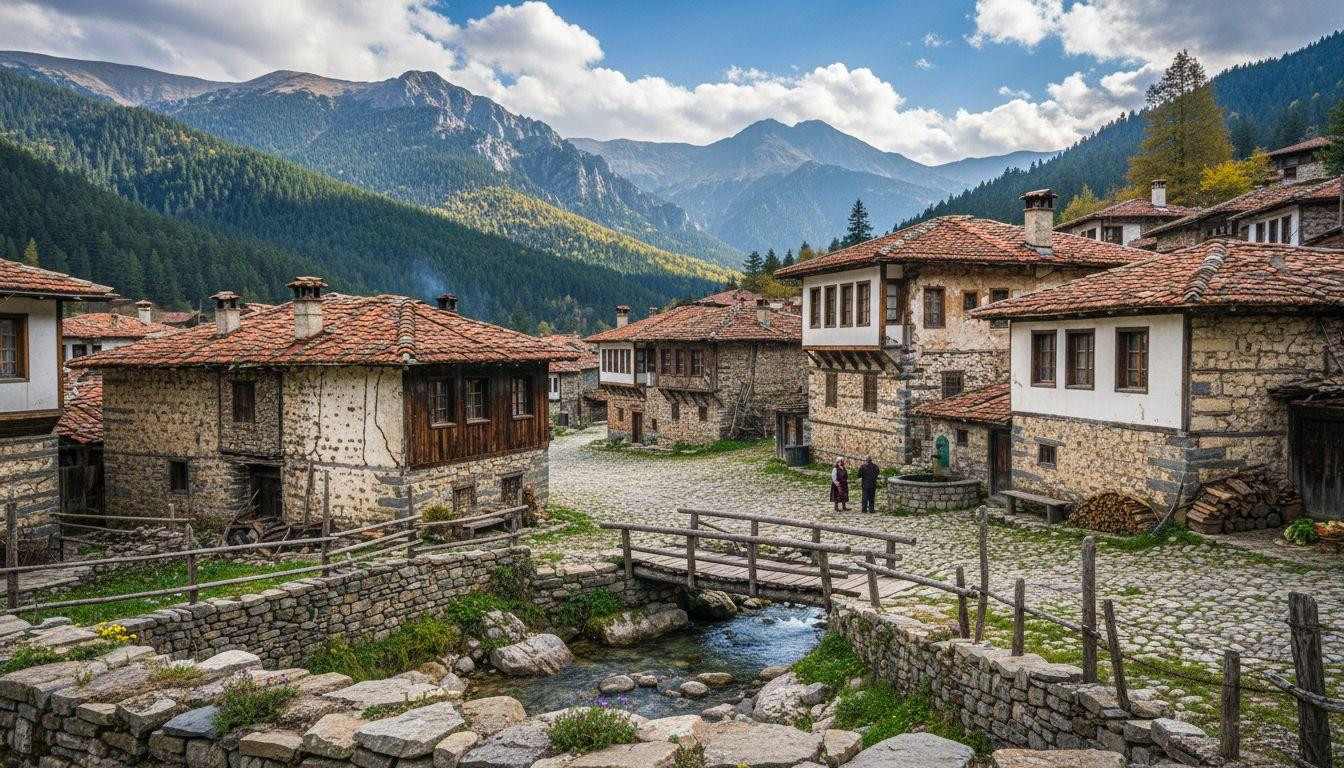Morning silence wraps around stone houses scattered across Bulgaria’s Rhodope Mountains, where time moves differently than anywhere else in Europe. In villages like Kotel, residents wake before dawn not from alarm clocks, but from roosters and church bells that have marked mountain rhythms for centuries. Here, living past 100 isn’t extraordinary. It’s simply what happens when modern stress never arrives.
Where time slows to mountain rhythms
Kotel sits 1,476 feet above sea level in Bulgaria’s eastern mountains, 75 miles from Sofia Airport. The drive takes 2 hours through winding roads that cross five log bridges over ice-cold streams. Stone houses with red-tiled roofs climb hillsides where wild herbs grow between cobblestones.
The town of 5,329 residents preserves 19th-century architecture despite a devastating 1894 fire. Ottoman-era foundations support homes where three generations still live together. Morning fog dissolves slowly here, revealing endless ridges that stretch toward Greece.
This isolation preserved something precious. While Bulgaria’s population declines (36,713 births versus 69,250 deaths in 2024), mountain communities like those in nearby Greece maintain traditional lifestyles that promote exceptional longevity.
The longevity secret nobody talks about
Bulgaria counts 325 centenarians nationally, with mountain regions showing remarkable concentrations. The Smolyan district in the Rhodopes documents over 430 residents aged 90-99, plus 60+ centenarians. Three-quarters live in remote villages where daily routines haven’t changed in generations.
What locals eat daily
Mountain residents consume homemade dairy, wild herbs, and rakia (fruit brandy) produced from family recipes. Gardens provide fresh vegetables year-round. Meals follow seasonal rhythms, not convenience schedules. Local honey contains mountain wildflower nectar that traditional European villages have treasured for centuries.
Why stress never arrived
Residents sleep 8 hours nightly, work in moderation, and rest when tired. Agricultural rhythms prevent psychological overload. Extended families provide emotional support systems that urban environments cannot replicate. Physical labor replaces gym memberships, while social connections combat isolation.
Living the Rhodope rhythm
Village life begins at 5am with fresh bread baking in wood-fired ovens. Kafene (coffee houses) open by 6am, serving Turkish coffee to farmers before field work. Conversations flow in Bulgarian dialects unchanged for centuries.
Morning in a mountain village
Local markets offer wild mushrooms, mountain cheese, and herbs collected from 7,200-foot peaks. Women in traditional dress sell preserves made from recipes passed down 5 generations. Men gather at stone tables, discussing weather patterns and family news.
Centenarians join these daily gatherings, walking unassisted to share stories. Their presence isn’t remarkable here. It’s expected, like mountain sanctuaries worldwide where natural rhythms support extraordinary human longevity.
Hiking through ancient forests
The Wonderful Bridges span marble gorges carved by underground rivers. Devil’s Throat Cave echoes with 130-foot waterfalls that have carved limestone for millennia. Womb Cave attracts couples seeking fertility blessings from local folklore.
Forest trails connect villages through fir-shaded valleys where healing herbs grow wild. These walks aren’t exercise routines but transportation methods that naturally maintain physical fitness throughout lifespans extending past 100 years.
Why November changes everything
Tourist numbers drop 80% after October, revealing authentic village life. Rhodope Mountains receive 500,000 annual visitors compared to Santorini’s 2 million. November temperatures hover around 50°F, perfect for hiking without summer crowds.
Accommodation costs $25-55 nightly in family guesthouses. Traditional meals cost $12-18 per person, featuring local specialties like shopska salad and Rhodope-style lamb. Car rentals from Sofia Airport average $35 daily, making independent exploration affordable for remote European villages seeking authentic experiences.
Cave entrance fees range $11-16 per person, while guided hiking tours cost $22-33 daily. These prices remain 40% below Western European equivalents, preserving accessibility for travelers seeking longevity secrets without luxury resort premiums.
Your questions about Kotel, Bulgaria, Rhodope Mountains, European longevity region answered
How do I get there from the US?
Fly into Sofia Airport (10-12 hours from New York, 13-14 hours from Los Angeles). Rent a car for the scenic 2-hour drive to Kotel, or take limited train connections through Plovdiv. Mountain roads are well-maintained but narrow, requiring careful navigation.
What does it really cost?
Budget $45-75 daily including accommodation, meals, and activities. Family guesthouses charge $25-40 nightly, while 3-star hotels cost $55-88. Restaurant meals average $12-18 per person. Gas costs $5.50 per gallon, making day trips between villages affordable.
Is the longevity reputation authentic?
Historical records document exceptional longevity in Rhodope communities, though current village-specific data isn’t readily available. Traditional lifestyles emphasizing natural foods, physical activity, and strong social connections align with Blue Zone characteristics found in other longevity regions worldwide.
Church bells ring across stone villages as morning fog lifts from ancient ridges. In Kotel, time moves at the pace of mountain streams and human heartbeats that have learned to last a century.
